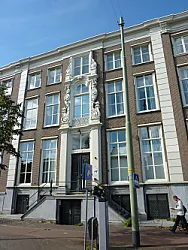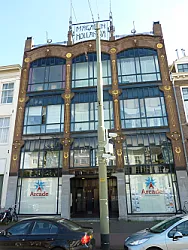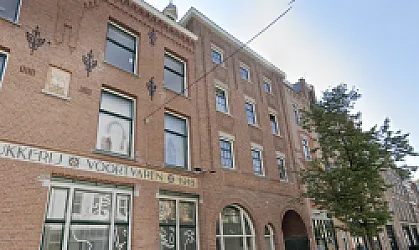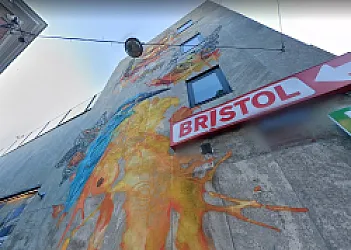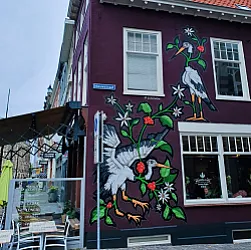Visit The Hague in 2 days
10 must-see POIs, optimized routes and anecdotes.
Loading map...
You will visit the most beautiful points of interest in The Hague
2 Days in The Hague — A Short Love Letter and Practical Plan
The Hague stole my heart the moment I stepped off the tram. It feels like a quietly confident city, equal parts royal dignity and cozy neighborhood charm. Known as the "City of Peace and Justice," it wears its history gently. Some say it’s overrated, but I found it deeply surprising and warm. I visited in spring, and those canals, narrow streets, and hidden courtyards still glow in my memory.
Why visit? Because The Hague is more than government buildings. It hums with small pleasures. You’ll wander from stately façades to intimate cafés. See the modern curve of The Three Steps, stroll along Prinsegracht, and discover vintage treasures at Magazijn Hollandia. The air sometimes carries sea salt and coffee. You’ll hear bicycle bells, muffled conversations, and church bells at dusk. Expect moments of quiet wonder, a sense of history underfoot, and places that invite slow exploration. This is what makes a first encounter unforgettable.
Planning a trip can feel overwhelming. There is so much to see you could stay for weeks. If this is your first time in The Hague, it’s easy to fret about missing out. I know the feeling—too many options, too little time. That’s why I crafted this The Hague itinerary for busy explorers. Below, I’ll show you exactly how to spend 2 days in The Hague and still leave feeling satisfied. You’ll cover architecture, museums, and hidden local spots without rushing.
Key tip: Start early and book any museum or special exhibition tickets online before you go. Lines thin in the morning. Popular spots fill up by midday. This frees you to enjoy quiet canals and take photos without crowds. It also gives you flexibility to linger at places like Prinsegracht or Magazijn Hollandia. Trust me—an early start turns a frantic day into a joyful one.
Ready to see what to see in The Hague and follow a friendly, compact plan? Now let’s dive into the itinerary and make your two days feel like a local love story.

Quick Mini Guide to The Hague
Where to stay:
- Centrum near Prinsegracht — central for the Binnenhof, The Three Steps and short walks to museums and canals.
- Statenkwartier/Europol area — quieter, near embassies and upscale cafés like Hofdame Anna for refined evenings.
- Scheveningen — if you want seaside sunsets and easy access to Ooievaars and beachside dining.
When to visit:
- Late spring–early autumn for pleasant beach weather and open-air events around the harbour.
- Weekdays for calmer streets around government buildings; evenings are livelier near Concordia CC for concerts.
Things to do (2-day plan):
- Day 1: Start at Prinsegracht, stroll the canals, see The Three Steps and pop into Magazijn Hollandia for local crafts.
- Day 1 evening: Concert or show at Concordia CC; dine near Hofdame Anna to sample modern Dutch cuisine.
- Day 2: Beach walk at Scheveningen, visit Ooievaars café/market spots, then join an interactive tour — The Walter Case THE HAGUE or The Alchemist THE HAGUE.
- Buy tram tickets/contactless for short hops; plan routes between cultural pockets rather than long transfers.
Don't forget:
- Windproof layer for coastal gusts and a small umbrella — weather changes fast.
- Most places prefer contactless payment; validate travel on trams/buses.
- Check show/tour times for Concordia CC, The Walter Case and The Alchemist and reserve in advance.
Day 1 - The Hague
5 POIs to discoverDay 1 - Morning à The Hague
5 Points of interest - Duration : 4h30 - Distance : 1.1 km - Walking : 0h14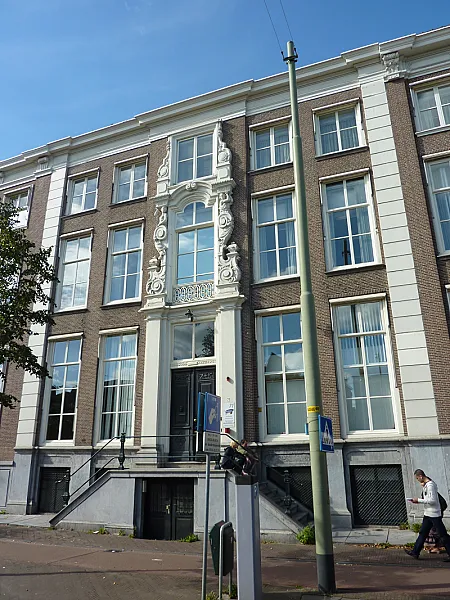
The Three Steps
- "De Drie Stoepen" refers to three neighboring national monuments from the first half of the 18th century that have functioned as a housing, museum, courthouse, official residence, and temporary location of the Permanent Court of Arbitration.
- The houses were built on previously undeveloped land that was used only for agriculture until a master builder named Frans van Braxhoofden constructed two of them in 1726-1728, designed in a Louis XIV and Louis XVI style.
- His involvement with the construction of the third house during 1728-1730 remains uncertain.
- The residences housed prestigious occupants, including the secretary of the Societëteit van de Hoge Collegien and The Hague, Paulus van Assendelft, High Council clerk Nicolaas van der Haar, three mayors of The Hague, and Major General Alexander Sweder, among others.
- By the 19th century, the houses were mainly preserved in their original condition and hosted important figures like the Swedish ambassador, a politician and member of The Hague council, and a British businessman and art collector.
- One of the houses, number 71, was used for several cultural and administrative functions during the 19th and 20th centuries, including a courthouse, a residency for various notable figures, and a temporary location for the Nederlandsch Museum for History and Art.
- In 1901, it also served as the headquarters for the Permanent Court of Arbitration until 1913.
- From 1918 to 1968, the buildings were collectively owned by Society for the Exploitation of the Association Building 'De Drie Stoepen N.V.', where it was primarily used for meetings, theater performances, rehearsals, and courses by the Social Democratic Workers Party (SDAP).
- Afterwards, it became a hotspot in the music and nightlife scene, hosting notable performances.
- After restoration in 1968, it has since been occupied by various public health institutions.
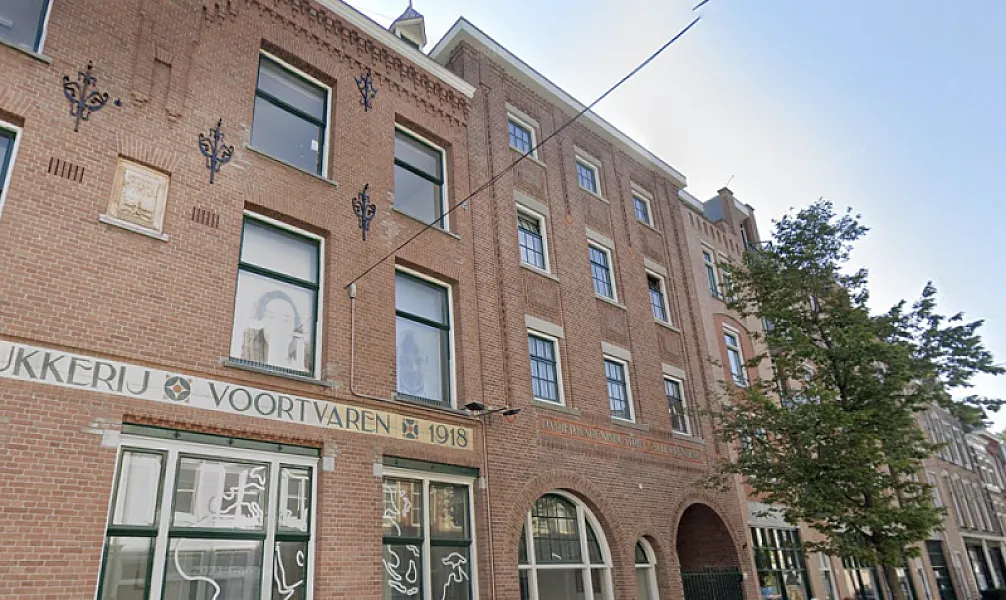
Concordia CC
- Operated by The &CC Foundation, it serves as a booster, connector, and facilitator for the arts community.
- The building has a rich history as a theater, museum, and conference location, with a size of approximately 1,500 m².
- The theater hall can accommodate around 300 visitors, and the municipality has rented out 16 studios at the Concordia location.
- Concordia CC partners with OPERA2DAY and Firma MES, contributing to a sustainable art ecosystem.
- It also houses the editorial office of the Nieuwe Haagsche Courant and has been a meeting center since 1995.
- The &CC Foundation has been operating Het Koorenhuis since 2013, emphasizing connection and creative entrepreneurship.
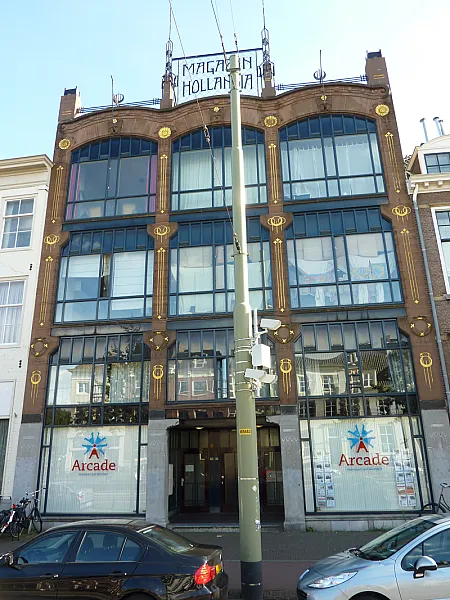
Magazijn Hollandia, Prinsegracht, The Hague
- The former "Magazijn Hollandia" department store, was built in 1908 in the style of the Viennese Secession, and designed by A.W.
- It was restored and converted into 13 homes and 2 retail spaces by Ton Deurloo Architects in 1987-1988.
- Its ornamental details were restored with gold and silver leaf during the 1987-1988 restoration.
- Its original layout changed in 1954, with the characteristic steel structure reconverted entirely to concrete; it was restored in 1987-1988.
- It is significant for being an early 20th-century department store with a steel skeleton and transparent facade.
- It holds architectural historical value as a representative example of the Viennese Secession style.
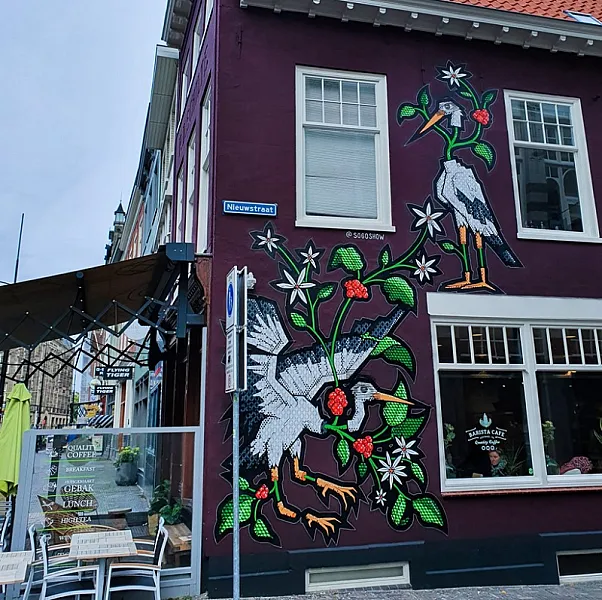
Ooievaars
- They belong to the family Ciconiidae and are large birds with long legs and necks, noted for their snavelgeklepper for communication. They prefer moist areas and feed on insects, rodents, amphibians and other aquatic inhabitants.
- They are monogamous and lack a vocal call. Ooievaars feature large bodies, long legs, elongated necks and stout, straight bills.
- They have a stately gait and fly with their necks outstretched.
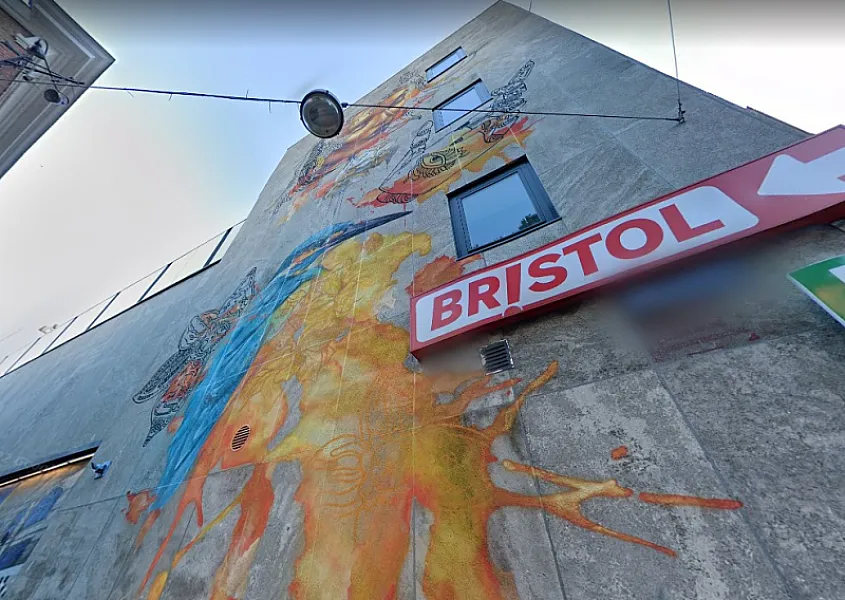
Hofdame Anna
- Anna Paulowna, born in 1795 in St.
- Petersburg, Russia, was a Grand Duchess of Russia from the Romanov dynasty.
- She married King Willem II and became Queen of the Netherlands from 1840 to 1849. Anna was the daughter of Russian Tsar Paul I and the sister of Tsar Alexander I.
- Her marriage to the Dutch Crown Prince (later King Willem II) was arranged by her brother. The marriage took place in 1816 in St.
- Petersburg, and despite her Russian Orthodox faith, the Dutch royal family accepted Anna's desire to continue practicing her religion. Upon ascending the Dutch throne in 1840, Anna Paulowna maintained the formalities of the Russian court, emphasizing etiquette during her reign as Queen of the Netherlands. Anna Paulowna passed away in 1865 near The Hague.
- She and King Willem II had five children, including the future King Willem III.
Day 2 - The Hague
5 POIs to discoverDay 2 - Morning à The Hague
5 Points of interest - Duration : 4h30 - Distance : 1.1 km - Walking : 0h14
The Three Steps
- "De Drie Stoepen" refers to three neighboring national monuments from the first half of the 18th century that have functioned as a housing, museum, courthouse, official residence, and temporary location of the Permanent Court of Arbitration.
- The houses were built on previously undeveloped land that was used only for agriculture until a master builder named Frans van Braxhoofden constructed two of them in 1726-1728, designed in a Louis XIV and Louis XVI style.
- His involvement with the construction of the third house during 1728-1730 remains uncertain.
- The residences housed prestigious occupants, including the secretary of the Societëteit van de Hoge Collegien and The Hague, Paulus van Assendelft, High Council clerk Nicolaas van der Haar, three mayors of The Hague, and Major General Alexander Sweder, among others.
- By the 19th century, the houses were mainly preserved in their original condition and hosted important figures like the Swedish ambassador, a politician and member of The Hague council, and a British businessman and art collector.
- One of the houses, number 71, was used for several cultural and administrative functions during the 19th and 20th centuries, including a courthouse, a residency for various notable figures, and a temporary location for the Nederlandsch Museum for History and Art.
- In 1901, it also served as the headquarters for the Permanent Court of Arbitration until 1913.
- From 1918 to 1968, the buildings were collectively owned by Society for the Exploitation of the Association Building 'De Drie Stoepen N.V.', where it was primarily used for meetings, theater performances, rehearsals, and courses by the Social Democratic Workers Party (SDAP).
- Afterwards, it became a hotspot in the music and nightlife scene, hosting notable performances.
- After restoration in 1968, it has since been occupied by various public health institutions.

Concordia CC
- Operated by The &CC Foundation, it serves as a booster, connector, and facilitator for the arts community.
- The building has a rich history as a theater, museum, and conference location, with a size of approximately 1,500 m².
- The theater hall can accommodate around 300 visitors, and the municipality has rented out 16 studios at the Concordia location.
- Concordia CC partners with OPERA2DAY and Firma MES, contributing to a sustainable art ecosystem.
- It also houses the editorial office of the Nieuwe Haagsche Courant and has been a meeting center since 1995.
- The &CC Foundation has been operating Het Koorenhuis since 2013, emphasizing connection and creative entrepreneurship.

Magazijn Hollandia, Prinsegracht, The Hague
- The former "Magazijn Hollandia" department store, was built in 1908 in the style of the Viennese Secession, and designed by A.W.
- It was restored and converted into 13 homes and 2 retail spaces by Ton Deurloo Architects in 1987-1988.
- Its ornamental details were restored with gold and silver leaf during the 1987-1988 restoration.
- Its original layout changed in 1954, with the characteristic steel structure reconverted entirely to concrete; it was restored in 1987-1988.
- It is significant for being an early 20th-century department store with a steel skeleton and transparent facade.
- It holds architectural historical value as a representative example of the Viennese Secession style.

Ooievaars
- They belong to the family Ciconiidae and are large birds with long legs and necks, noted for their snavelgeklepper for communication. They prefer moist areas and feed on insects, rodents, amphibians and other aquatic inhabitants.
- They are monogamous and lack a vocal call. Ooievaars feature large bodies, long legs, elongated necks and stout, straight bills.
- They have a stately gait and fly with their necks outstretched.

Hofdame Anna
- Anna Paulowna, born in 1795 in St.
- Petersburg, Russia, was a Grand Duchess of Russia from the Romanov dynasty.
- She married King Willem II and became Queen of the Netherlands from 1840 to 1849. Anna was the daughter of Russian Tsar Paul I and the sister of Tsar Alexander I.
- Her marriage to the Dutch Crown Prince (later King Willem II) was arranged by her brother. The marriage took place in 1816 in St.
- Petersburg, and despite her Russian Orthodox faith, the Dutch royal family accepted Anna's desire to continue practicing her religion. Upon ascending the Dutch throne in 1840, Anna Paulowna maintained the formalities of the Russian court, emphasizing etiquette during her reign as Queen of the Netherlands. Anna Paulowna passed away in 1865 near The Hague.
- She and King Willem II had five children, including the future King Willem III.
Where to Stay in The Hague
Choosing where to sleep in The Hague matters more than you might expect for a short two-day visit: the city is compact but its character changes street by street, and picking the right base saves travel time so you can relax between visits to places like The Three Steps and Magazijn Hollandia. Stay centrally if you want to stroll canals and cafés in the morning and be back for an evening concert, or pick a quieter residential quarter if you value restful nights after a full day of exploring.
The Hague is organised around a clear centre with radiating neighbourhoods along canals, boulevards and the coast. Most sights cluster in and around the historic city centre and the adjacent districts, while the beach district and green avenues are a short tram or bike ride away. Understanding this layout helps you choose a neighbourhood that positions you for what matters: culture, canals, or coastline. Practical touchstones to look for on maps are city-centre canals (like the Prinsegracht area), cultural venues (such as Concordia CC), and lively local streets with good tram access.
For easy access to the attractions on your list, aim for a base in or near the central quarters such as the Centrum or the adjacent Zeeheldenkwartier and Archipelbuurt, where you’ll be within comfortable walking distance of canals, theatres and independent shops. If you prefer a taste of seaside life after sightseeing, staying toward Scheveningen or the Statenkwartier gives quick access to the coast while keeping you a short tram ride from hotspots like Ooievaars and cosy neighbourhood spots such as Hofdame Anna.
Transport around The Hague is straightforward: the tram network is dense and reliable, regional trains connect you to major stations (Den Haag HS and CS), and the city is famously bike-friendly — a short cycle often beats longer public-transport journeys. Buy or top up a public transport card and pick accommodation near a tram stop or station to reduce stress when you’re on a tight schedule.
Finally, be reassured that for a two-day stay you don’t need to be perfect — prioritise a neighbourhood that matches your rhythm (late dinners, museums first thing, or beach time) and choose lodging with easy access to trams or a bike rental. A comfortable, well‑located room turns a busy itinerary into an enjoyable, low‑stress break in The Hague.
Getting Around The Hague
The Hague is delightfully easy to explore by public transport — compact, well-signposted and run by a reliable local network that even first-time visitors find approachable. The city centre is threaded with frequent HTM trams and buses that knit together squares, museums and canals, while the faster RandstadRail and regional NS trains connect you to stations like Den Haag Centraal and Hollands Spoor. Timetables are frequent, vehicles are modern, and stops are close together, so you rarely need to plan more than ten minutes ahead. 🚇
Practical tip: get familiar with the OV-chipkaart system or simply use contactless payment. You can pick up an anonymous OV-chipkaart at stations or buy disposable e-tickets from machines, but increasingly you can just tap with a debit/credit card or mobile wallet when boarding trams and buses. Keep in mind you must check in and check out with an OV-chipkaart; if you use contactless bank payment, the system will handle fares automatically. For occasional travellers, disposable tickets or a day pass from HTM can be the easiest option. 🎫
For routing, I always combine Google Maps with the Dutch planner 9292 — both give live departures, platform numbers and walking times. Google is great for on-the-go directions and walking routes between charming streets like Prinsegracht and nearby stops, while 9292 or the NS app is excellent for edge cases (service changes, engineering works or late-night alternatives). Keep your phone charged and enable live departures so you know whether to sprint for the next tram or enjoy a relaxed coffee.
To save money, walk when you can — the centre is wonderfully walkable — or rent a bike for short bursts. Multi-day passes and day tickets are worthwhile if you plan multiple hops; otherwise pay-as-you-go with contactless often ends up cheaper for a couple of short trips. Also travel off-peak when possible: trains and trams are less crowded and you’ll enjoy more space to soak in the canals and architecture. 💡
Speaking from experience: once we needed to get from The Three Steps to Prinsegracht with a stop at Magazijn Hollandia and a quick detour to Concordia CC. We checked Google Maps, spotted a tram two minutes away, tapped in with a contactless card, and got off two stops later to stroll past Magazijn Hollandia. The tram ride plus a ten-minute walk dropped us right on Prinsegracht — easy, scenic and stress-free. That mix of short tram hops and pleasant walking is how I recommend you explore The Hague. 🗺️
What to Pack for The Hague
I love The Hague for its stately government buildings, quick tram hops between squares, and the way the North Sea wind reshapes a day out. On a 48-hour loop I once walked nearly 12 miles between the Binnenhof, Lange Voorhout and Scheveningen viewpoints, so I pack light but smart. Below are the essentials I take every time, with the practical reasons behind them and a little anecdote from my trips.
1. Comfortable walking shoes (REQUIRED — e.g., Ecco Soft 7 or Merrell Moab 2): The Hague’s mix of cobblestones, tram tracks and paved promenades punishes flimsy shoes. I wore new sneakers once and my feet hurt after 8 miles; since switching to cushioned, broken-in shoes (I use Ecco Soft 7), I’ve done 12–15 miles in a day without blisters. Bring shoes you can be on your feet in for 8–10+ hours.
2. Cross-body bag (zippered, anti-theft if possible): I keep passport, phone and tram card in a compact cross-body with a zip—hands-free for photos and safer in crowded spots like the Binnenhof. On a busy market day I felt a hand slip near a stall; the zipped bag kept everything secure and accessible without slowing my walk.
3. Weather-appropriate clothing: layers + a packable rain jacket: The Hague can flip from sunny to drizzly in under an hour and the sea wind is brisk. I always carry a thin merino layer and a packable waterproof—on one visit rain arrived around 4pm and my jacket kept me exploring the Lange Voorhout sculptures until dusk.
4. European power adapter (Type C/F, 230V): Keep a small adapter so phone, camera and any chargers work the moment you arrive. I once landed with a dead camera battery and no adapter—cost me an afternoon hunt for a shop. Plug-ready gear means photos and maps stay alive.
5. Power bank (10,000 mAh): Between mapping routes, taking architecture photos and checking tram times, my phone drains fast. A 10,000 mAh power bank gave me two full charges on a 10+ hour day when I was shooting facades along the Oude Centrum.
6. Reusable water bottle (collapsible): Walking around the city all day dehydrates you, especially with wind. I refill at cafés or public fountains—saved me money and kept me going during a 9-hour stroll through the city’s historic quarter.
7. Optional — Compact travel umbrella: If you hate surprises from the sky, a tiny umbrella can save a museum-less itinerary when showers pop up.
8. Optional — Small sketchbook or notebook: For architecture lovers: I jot notes or sketch façades on the spot. It’s my favorite way to remember details a photo sometimes misses.
Enjoy Your Trip to The Hague!
Voilà un itinéraire de 2 jours à The Hague, rempli de découvertes et d'émotions: 5 lieux essentiels pour saisir l'âme de la ville. De The Three Steps à Magazijn Hollandia, en passant par Prinsegracht et Concordia CC, ce programme est rempli de tout ce qu'il vous faut pour un court séjour riche et inspirant.
N'oubliez pas: ceci est un GUIDE, pas un calendrier strict. Prenez le temps, soyez flexible et surtout laissez de la place à l'imprévu. La magie arrive souvent quand on se perd un peu, quand on s'arrête dans un café au hasard ou qu'on suit une rue qui intrigue. Ne cherchez pas à voir tout à la fois — choisissez la qualité des moments plutôt que la quantité.
Je vous assure que vous allez passer un merveilleux week-end. J'espère que vous reviendrez avec des souvenirs inoubliables et le cœur léger. Je suis vraiment enthousiaste pour vous et je suis sûr que The Hague vous offrira des moments surprenants, chaleureux et plein de caractère.
Envie d'explorer de façon ludique ? Essayez les parcours interactifs Coddy: The Walter Case THE HAGUE et The Alchemist THE HAGUE rendent la découverte plus amusante et immersive. Consultez ces options si vous voulez ajouter un jeu d'enquête à votre balade en ville.
Profitez pleinement, laissez-vous surprendre et revenez partager vos histoires si le cœur vous en dit — Bon voyage !
Want more adventure?
Discover our urban escape games to transform your visit into an interactive adventure!










